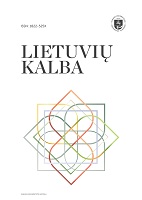PLUNGĖS GEOLEKTAS REGRESYVINĖS BALSIŲ I, U ASIMILIACIJOS POŽIŪRIU
THE GEOLECT OF PLUNGĖ IN TERMS OF REGRESSIVE ASSIMILATION OF VOWELS I, U
Author(s): Simona VyniautaitėSubject(s): Phonetics / Phonology, Sociolinguistics, Baltic Languages
Published by: Vilniaus Universiteto Leidykla
Keywords: Lithuania; geolect of Plungė; vowels; "i"; "u"; vowels assimilation;
Summary/Abstract: Based on dialectometric methods, the article discusses the geolect of Plungė in terms of regressive assimilation of vowels i, u. The study material consists of about 9 hours of audio recordings, 57 sentences, recited by nine presenters of younger, middle and older generations. 6 words were chosen in which regressive assimilation of vowels can take place, i. e., the words with vowels i, u in accented, unaccented and shifted accent positions. Quantitative analysis of the material (sentences read by the presenters) was performed with the tools of the computer program Gabmap. Pseudo maps of networks, reference points, cluster analysis, as well as differential dialectal features were analyzed. The analysis performed using dialectometry methods shows that differences in limb reduction, word stem, consonant softening become apparent, but in many cases regressive assimilation of vowels i, u becomes the main variable feature. The operation/inaction of the regressive assimilation of vowels i, u is greatly influenced by accent. When vowels are accented, presenters of all generations pronounce them without regressive vowel assimilation. When the vowel i is unaccented, it is assimilated, and the vowel u is spelled narrowly by only a third of the presenters. Dual behavior exists in cases where vowels receive a shifted accent. The pronunciation of both vowels is approximate. Maintaining the main distinguishing feature of the residents of Plungė from the dialect of the residents of Telšiai, although inconsistent, would allow predicting that the linguistic dialect peculiarity of this area could compete with the language code of Telšiai – based on the Samogitian regiolect – or whether the regiolect itself would be / become dual-core (more detailed research based on a multi-faceted research model is needed to confirm this statement). The effect of regressive assimilation in the Plungė dialect, in the geolectic zone in general, can be both a proof of resemblance to the northern Samogitian Telšiai residents and a sign of a decrease in the importance of assimilation as a distinctive feature of the dialects.
Journal: Lietuvių kalba
- Issue Year: 2020
- Issue No: 14
- Page Range: 1-19
- Page Count: 19
- Language: Lithuanian

